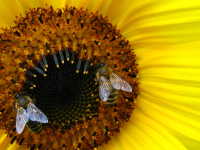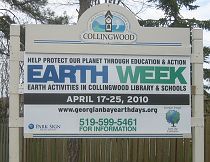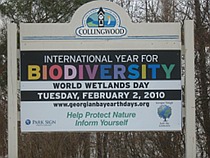Archive for August, 2009
Summer Reading to Make Us Rise Up and Act for our Children
Andrew Barnosky is a paleoecologist. His new book, “Heatstroke: Nature in an Age of Global Warming”, speaks of four bad players creating the destruction of many ecosystems around the world: population, global warming, invasive species and forest fragmentation. Professor Barnosky’s a scientific Sherlock Holmes who looks at how the world’s climate has constantly changed over millions of years. This sleuth brings us to caves and other places, including Yellowstone National Park that show the fossil evidence of climate change as well as extinctions over millions of years. With the greatest of clarity he explains his scientific terminology and is able to show the reader that in the past million years biodiversity has been able to ride out the worst of glacial or inter-glacial changes. Here’s an important word that we should all become acquainted with: ‘phenology’. It describes the correlation between climate and the natural cycles of nature such as migration of birds, hunting for food, polar bears or plant flowering. He says that species can’t keep up with humanity’s unprecedented tampering with Earth’s climate; extinctions are happening at an alarming rate compared to what has occurred in the last several hundred thousand years. As well, huge human population increases in the last (and the next) fifty years pose some of the greatest threats to the stability of our planet’s ecosystems. Invasive species has lowered the wealth of biodiversity, making the Earth one big box store of the same species.
“The trick now, of course, is to actually use our foresight and abilities not only to dodge but also to deflect the bullets heading our way- including, perhaps especially, the ones aimed squarely at Earth’s ecological heart…The reason Earth is in peril is because of individual actions. Just as the problem is the sum of what each one of us is doing, so is fixing the problem. That means we each hold a little part of the future of the world in our hands. “
Richard Wilkinson and Kate Pickett’s 2009 book “The Spirit Level: why more equal societies almost always do better” enables us to understand how we can make a difference in creating a better world It is very clearly argued in the “Spirit Level” that the more equal a society is, the better it is able to wrestle with many of our problems, including global warming, and create a healthier, safer and happier nation.
Even though there are many graphs and statistics throughout the book, it never becomes one more academic treatise. The authors are really speaking to us in the West and particularly in North America, saying the vast inequality between rich and poor is bringing down our society. As well, our monstrous carbon footprint points to an unhappy group of people addicted to consumerism. These excesses include the self-indulged use of planes and cruises as well as creating a disastrous cult around the priority of economic growth over Nature and community. Flying or boating into a pristine sensitive destination such as the Galapagos Archipelago as an ‘eco-tourist’ is many times defended because of the economic benefits that are derived from such tourism. It’s far better to stay close to home to enjoy Nature. The authors of ‘Spirit Level” show in great detail that more equal societies such as Cuba, Norway or even Japan are also much happier societies. Finally, a ‘steady-state economy’ keeps unwarranted growth at bay but need not be a stagnating society. Living within our ecological means creates a more resilient and creative people in balance with each other and the biosphere.
These are just two excellent reading possibilities. W.H. Hudson’s ”Far Away & Long Ago: A childhood in Argentina” will inspire anyone who wants Nature to return to its former splendour, Chris Goodall’s “How to Live a Low-Carbon Life: the individual’s guide to stopping climate change” is a great gift for a true friend who needs to drastically lower their carbon footprint and won’t hate you for telling her it’s time to change.
Biophysical Economics and the Limits to Growth
“Common Sense is the collection of prejudices acquired by age eighteen.
We cannot solve our problems with the same thinking we used when we created them.”
Albert Einstein
During the 18th century a group of politicians and economists in France realized that unless governments are guided by a policy that respects and works within the laws of Nature that govern our ecosystems, no economic system can last for long. Economics, guided by Natural Law, would be the basis of a strong and sustainable agricultural society. These people were called Physiocrats. Unfortunately, François Quesnay and his disciples’ balanced economic policies were soon overshadowed by the industrial revolution. However, in the 19th century, scientists such as Carnot, Ostwald and a social scientist named Podolinsky were all inspired by the discovery of the Laws of Thermodynamics. They began the process of expanding economic theory to include a human interwoven dependency on Nature and energy. By realizing that there are limitations and laws regulating the use of energy, these people advocated a more holistic approach to economics. Like the Physiocrats, these forward thinking people realized that all economic growth must be held accountable to physical and ecological laws. In other words, we ought to seek out a sustainable policy in energy usage. Modern Biophysical Economics or Steady-State-Societies acknowledge ecological services as the basis for any economy. Limitless growth economic models must be abandoned.
Our recent economic crash makes it imperative that we create a new economy based on the thoughts of these prescient people. The limits of economic growth can be found to have a mirror in Nature. Our energy derived from solar income is vast compared to our dwindling stored solar income found in fossil fuels. Alternatives to fossil fuels need to be the basis of a new biophysical economy acted out within strict ecological guidelines. Self-imposed limits on growth are far better than the ones Nature will dictate if humanity doesn’t act swiftly to discard old economic models.
Humans will do anything rather than give up their allegiance to business-as-usual models. In the August 6 issue of the science journal ‘Nature’, we are told real flaws have existed in our economic models. Those models try to forecast at most a year ahead or run our economies as if we are in a perfect world that can’t even conceive of the crises that now assail us. “As a result, economic policy-makers are basing their decisions on common sense. The leaders of the world are flying the economy by the seat of their pants. “, J. Doyne Farmer and Duncan Foley tell us.
Schemes such as having several thousand wind-powered ships spray water from the oceans to make white vapour clouds that solar radiation bounce off of, is one of many geo-engineering ideas now circulating. We’ll do anything to circumvent simpler solutions that actually lower greenhouse gas emissions but are perceived as getting in the way of growth. Geo-engineering is viewed as the panacea of climate change deniers, corporations and policy makers that wish to prop up institutions that will inevitably collapse anyway once stimulus and bail-out packages are shown to be what they are. The greatest tragedy of these bail-outs is the wealth that has been squandered while more humanistic solutions such as decentralized community projects flounder due to a lack of capital.
If future generations are to even have a modicum of success we need to look more closely at Albert Einstein’s playful and creative approach to problem solving. As well, societies have to have more faith in its young people and nurture their creativity by letting them not only sit at the decision-making table but encourage them to take the lead. Instead of governments spending trillions of dollars on throwing fraying life-lines to sinking and bloated centralized top-down-bonus-ridden companies, they should ask young adults how money should be spent. Democratic decision–making must employ the ingenuity of the young.
‘Bee’ a friend to nature – be a beekeeper.
“I will arise and go now, and go to Innisfree,
And a small cabin build there, of clay and wattles made:
Nine bean-rows will I have there, a hive for the honeybee,
And live alone in the bee-loud glade.” W.B. Yeats “The Lake Isle of Innisfree”
 Recently in Britain 1,000 people showed up to enroll in a single course for novice bee-keepers. People throughout the world know that bees are in trouble after reading about Colony Collapse Disorder and want to do what they can to stop the honey bees’ decline. By 2006 most apiarists were reporting up to one-third of their bees gone or dead. Is it the various mites, pesticides, long distance traveling that wears down our friends? The largest wild blueberry company in Maine called Wyman’s owns 10,000 acres of blueberry terrain and they know that their 125 year old business is finished if a solution is not found soon. They have given a large grant to scientists to try and find out what needs to be done. Citizen science is also coming forward and helping biologists to understand the problem. Gretchen LeBuhn started the Great Sunflower Project- see www.sunflower.org- to try to have a better knowledge of what bees were up to across Canada and the U.S. She has over 60,000 volunteers who plant a sunflower in their yard, watch for all sorts of bees and then send in their data. It’s a wonderful way to encourage young people to become naturalists and know how important all kinds of bees are for pollination.
Recently in Britain 1,000 people showed up to enroll in a single course for novice bee-keepers. People throughout the world know that bees are in trouble after reading about Colony Collapse Disorder and want to do what they can to stop the honey bees’ decline. By 2006 most apiarists were reporting up to one-third of their bees gone or dead. Is it the various mites, pesticides, long distance traveling that wears down our friends? The largest wild blueberry company in Maine called Wyman’s owns 10,000 acres of blueberry terrain and they know that their 125 year old business is finished if a solution is not found soon. They have given a large grant to scientists to try and find out what needs to be done. Citizen science is also coming forward and helping biologists to understand the problem. Gretchen LeBuhn started the Great Sunflower Project- see www.sunflower.org- to try to have a better knowledge of what bees were up to across Canada and the U.S. She has over 60,000 volunteers who plant a sunflower in their yard, watch for all sorts of bees and then send in their data. It’s a wonderful way to encourage young people to become naturalists and know how important all kinds of bees are for pollination.
After 22 years of keeping bees I can understand why men and women want this ultimate nature hobby. What is so unique about bee-keeping is the egalitarian interaction with another species. The European honey bee, Apis mellifera, is an equal in its relationship with humans. If a bee-keeper does not treat his bees with due respect, or if their lodging is not to their satisfaction, they may just fly away. Good beekeepers are careful to leave enough honey in the hive so the bees survive the winter. Pragmatism and outright admiration for these insect’s social order creates the perfect partnership.
We have all heard of the bee dances that communicate information to the colony. Observing bees enter their colony is an inspiring experience. For example, watch how bees use ‘air-conditioning’ to cool down the hive by using their wings to fan the hot air out of the colony on a scorching summer day. In the fall a person can see the sad exit of perhaps ninety-five percent of the drones (male bees) being shoved out of the colony so the workers and the queen have enough honey for the winter. Catching a swarm is always an adventure. Swarming bees are looking for a new place to live, and swarms of thousands of bees announce themselves with a huge buzz as they cling to a branch. Bees are very safe to work with when they are swarming. If you see a swarm, call a bee-keeper and they will be happy to come by and catch it. Never spray the honey bees with an insecticide. Most people know how important bees are for our local apple industry and vegetable gardens. Fifteen billion dollars of added crops can be directly related to pollination by bees in North America.
There is no bylaw against having bees in the Town of Collingwood. Our bees, in the Beaver Valley, are twenty feet from our house and no one has ever been stung as a result of the hives’ proximity to the house. It would be a good idea to have a fence around the bees or a fenced- in backyard if you live in town. Young people can learn so much by sitting quietly next to the colony and observing all the wonderful activity taking place. Children love extracting honey too. Once the fields of goldenrod have finished in the fall, it is a true celebration tasting the honey and honouring the bees’ work by making sure they have a cozy hive for the winter.

